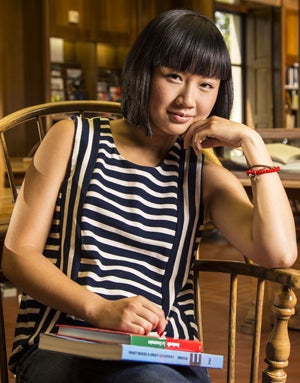Assembling a college collage of possibilities
 She approaches the sculpture slowly, almost reverently. What she has only seen in photos, she now sees in person—an elegant, glossy marble hand extending from a rough-hewn block of marble, which cradles two twisting, intertwined bodies. She sees arms, legs, feet, and hands, an expanse of thigh, a well-muscled back, a rounded breast—the ambiguous forms beautifully melded, but, as yet, incomplete.
She approaches the sculpture slowly, almost reverently. What she has only seen in photos, she now sees in person—an elegant, glossy marble hand extending from a rough-hewn block of marble, which cradles two twisting, intertwined bodies. She sees arms, legs, feet, and hands, an expanse of thigh, a well-muscled back, a rounded breast—the ambiguous forms beautifully melded, but, as yet, incomplete.
Outside, as central Paris pulses around the expansive green lawns of Musée Rodin, Karen Lue circles Rodin's "The Hand of God" silently. Here the artist has frozen an imagined moment in time, thinks Lue. And, here, she begins her quest: What can she discover about Rodin, his practice, this specific work? Why the sexual ambiguity of these figures, presumably Adam and Eve? Is this theme present in Rodin's other work, she wonders?
Over the summer of 2013, Lue—currently a senior at the University of Pittsburgh—explored these questions and more, thanks to a Brackenridge Research Fellowship she won through the University's Honors College. She studied abroad in France during spring 2013, working in the Musée Rodin archives. In Paris, she researched Rodin, delving into a rich treasure trove of primary source materials, such as newspapers and other French publications dating back to the early 1900s. Once she returned to Pittsburgh, she utilized the research fellowship to compile her findings.
"The whole process taught me better ways to research, and that you can't always find exactly what you're searching for," recalls Lue. "This was important, because rather than getting discouraged, it showed me how to keep pushing through my research with what I had found, and how I could put it together in a coherent way."
As a double major in the Dietrich School's Departments of History of Art and Architecture and Economics, with a minor in French, Lue excels at putting divergent concepts together in a reasoned way. After all, just consider her majors—pragmatic economics mixed with art and language.
"Economics is a good contrast to the history of art," Lue explains. "I work with problem sets and other straightforward concepts, which creates a good balance with the heavy reading, writing, and research I do for my history of art major."
Lue—who aspires to become a curator or educational director of a museum, gallery, or non-profit arts organization someday—also knows her two majors provide a marketable mix of skills that promise to serve her well in her future career.
For now, Lue is packing her résumé with a wealth of practical arts experience. She won a 2014 Milton Fine Museum Profession Fellowship and worked over the summer with the curator and assistant curator of Pittsburgh's Andy Warhol Museum. She helped with the museum's upcoming exhibitions and assisted with a variety of tasks, from making object packages (compiled lists of objects to be used in an exhibition with their relevant information) to composing expanded labels and wall text to writing posts for the Warhol blog.
A few months before Lue's stint at the Warhol, she worked as a curatorial assistant at the Frick Art and Historical Society, where she helped with the March 2014 exhibition, Visions and Revelations—a collection of work by members of the National Association of Women Artists that was exhibited at Point Park University’s Lawrence Hall Gallery.
Lue has also logged time as a teaching assistant for "Introduction to World Art" and as a research assistant for the Visual Media Workshop, where she helped create tutorial videos for an interactive Web site project.
While Lue does not graduate until the spring of 2015, she already knows her time at Pitt has been invaluable, allowing her to gain vital skills and experience.
"Pitt provides so many different scholarships and awards, particularly for research," she says. "I would have never thought that I would be able to receive money to travel to various archives and other sites to gather information for my honors thesis." Lue also mentions that Pitt offers a wealth of opportunities to publish and present research and other work.
In addition to exploring and presenting art through winning research and travel assistantships and fellowships, Lue is also mining her personal background as a first-generation Chinese-American for inspiration. (Her parents emigrated from Hangzhou, China, to Gainsville, Fla., in the late 1980s.)
In fact, Lue's honors thesis focuses on Chinese immigrants in Pittsburgh. She is researching how these immigrants preserved and showcased their cultural identity and heritage, particularly in the Cathedral of Learning's Chinese Nationality Room. What she has found so far has both piqued her interest and expanded her view of her own cultural identity.
"The Chinese Nationality Room was designed and created by Chinese for a predominantly White/Anglo-Saxon audience," explains Lue. "So, it's interesting to see how the Chinese wanted others to see their culture." Lue explains that the room focuses on Confucianism, with a "mish-mosh" of what many view to be quintessential Chinese design elements, such as a dragon on the ceiling and lucky dog statues at the entrance.
Lue is taking what she is learning about the Chinese Nationality Room and merging it with her research on Chinese immigrants in Pittsburgh in the 1920s and 1930s. She is also comparing her observations on Chinese identity in Pittsburgh with Chinese identity in other major U.S. cities.
"Researching this topic has really opened my mind to a new way of thinking about my culture and what it means to be Chinese-American," says Lue. "I am really proud of and thankful for my culture and my diverse experience growing up with both Chinese and American influences."
